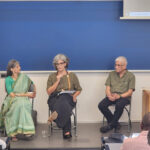by Walden Bello
It seems these days that whenever Mother Nature wants to send an urgent message to humankind, it sends it via the Philippines. This year the messenger was Yolanda, a.k.a. Haiyan.
For the second year in a row, the world’s strongest typhoon, Yolanda, barreled through the Philippines, following on the footsteps steps of Pablo, a.k.a Bopha, in 2012. And for the third year in a row, a destructive storm deviated from the usual path taken by typhoons, striking communities that had not learned to live with these fearsome weather events because they were seldom hit by them in the past. Sendong in December 2011 and Bopha last year sliced Mindanao horizontally, while Yolanda drove through the Visayas, also in a horizontal direction.
That it was climate change that was creating super typhoons that were taking weird directions was a message that Nature was sending not just to Filipinos but to the whole world, whose attention was transfixed on the televised digital images of a massive angry cyclone bearing down, then sweeping across the central Philippines on its way to the Asian mainland. The message that Nature was sending via Yolanda–which packed winds stronger than super storm Sandy, which hit New Jersey and New York last October, and Hurricane Katrina, which devastated New Orleans in 2005–was especially meant for the governments of the world that are assembling in Warsaw for the annual global climate change negotiations (COP 19) scheduled to begin Monday, November 11. Is it coincidence, ask some people who are not exactly religious, that both Pablo and Yolanda arrived at around time of the global climate negotiations? Pablo smashed into Mindanao during the last stages of the Conference of Parties 18 (COP 18) in Doha last year.
COP 19: Another Deadlock?
It is doubtful, however, that the governments assembling in Warsaw will rise to the occasion. For a time earlier this year, it appeared that Hurricane Sandy would bring climate change to the forefront of US President Barrack Obama’s agenda. It did not, and, while trumpeting that he was directing federal agencies to take steps to force power plants to cut carbon emissions and encourage movement towards clean energy sources, Obama will not send a delegation that will change the US policy of non-adherence to the Kyoto Protocol, which Washington signed but never ratified. Though 70 per cent of Americans now believe in climate change, Obama does not have the courage to challenge the fanatical “climate skeptics” that fill the ranks of the Tea Party and the US business establishment on this front.
It is also unlikely that the China, now the world’s biggest carbon emitter, will agree to mandatory limits on its greenhouse gas emissions, armed with the rationale that it is those that have contributed most to the cumulative volume of greenhouse gases like the US that must be subjected to mandatory emissions cuts. And as China goes, so will Brazil, India, and a host of the other more industrially advanced developing countries that are the most influential voices in the “Group of 77 and China” coalition. What the governments of these countries seem to be saying is that the carbon-intensive industrial development plans they are pursuing are not up for negotiation.
Dangerous Gap
According to the Durban Platform agreed upon in 2011, governments are supposed to submit carbon emissions reduction plans by 2015, which will then be implemented beginning in 2020. To climate scientists, this leaves a dangerous gap of seven years where no mandatory moves of emissions reduction can be expected from the US and many other carbon-intensive countries. It is increasingly clear that every year now counts if the world is to avoid a rise in global mean temperature beyond 2 degrees Celsius, the accepted benchmark beyond which the global climate is expected to go really haywire.
Countries like the Philippines and many other island-states are in the frontlines of climate change. Every year of massive and frequent disastrous climate events like Yolanda and Pablo reminds them of the injustice of the situation. They are among those that have contributed least to climate change, yet they are its main victims. Their interest lies not only in accessing funds for “adaptation.” (A Green Climate Fund that would funnel, beginning in 2020, $100 billion a year from rich countries to poor countries to help them adjust to climate change has been set up, but contributions so far have been small and slow in coming.) With typhoons and hurricanes now being on the cutting edge of extreme weather events, these frontline countries must push all major greenhouse gas emitters to agree to subject themselves to radical emissions cuts immediately, and not wait till 2020 to undertake this.
Unorthodox Tactics
During the Doha negotiations last year, one of the leaders of the Philippine delegation cried when he pointed to the ravages inflicted on Mindanao by Pablo. It was a moment of truth for the climate talks. This year, our delegation must convert tears into anger and denounce the big climate polluters for their continued intransigence against taking the steps needed to save the world from the destruction that their carbon-intensive economies have unleashed on us all. Perhaps, the best role our delegation can play is by adopting unorthodox tactics, like disrupting the negotiations procedurally to prevent the conference from falling into the familiar alignment of the rich North versus the Group of 77 and China, a configuration that guarantees a political deadlock even as the world hurtles towards the four degree plus world that the World Bank has warned will be a certainty without a massive global effort to prevent it.
Walden Bello represents Akbayan (Citizens’ Action Party) in the House of Representatives.









